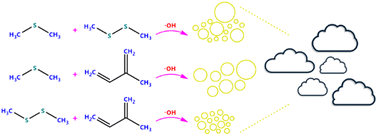Secondary aerosol formation from mixtures of marine volatile organic compounds in a potential aerosol mass oxidative flow reactor†
Abstract
Increasing recognition of the significant contributions secondary organic aerosols can make in marine environments has led to an increase in research focused on understanding the reactions controlling their formation. Most marine laboratory studies to date have focused on the oxidation of individual volatile organic compounds (VOCs), particularly dimethyl sulfide (DMS). Thus, a lack of understanding exists in how complex marine VOC mixtures affect secondary marine aerosol formation and composition. To address this gap, we conducted controlled lab experiments that compare the effects of oxidizing single common marine VOCs versus VOC mixtures on secondary marine aerosol production. We used a potential aerosol mass oxidative flow reactor to investigate marine-relevant VOCs, including DMS, dimethyl disulfide (DMDS), and isoprene. Ion chromatography, chemical ionization mass spectrometry, aerosol time-of-flight mass spectrometry, and particle sizing instruments were employed to study how these mixtures influence the overall composition of marine aerosols. Our findings reveal that mixtures significantly alter the production and composition of secondary marine aerosols. Specifically, we found that isoprene, when oxidized in the presence of DMS and DMDS, affects methanesulfonic acid (MSA) and sulfate ratios, as well as overall aerosol yields. These insights suggest further studies on realistic marine VOC mixtures will help understand and predict the dynamics of secondary marine aerosol formation, therefore improving air quality and climate models and enabling more accurate predictions of marine aerosol impacts on cloud formation and properties.



 Please wait while we load your content...
Please wait while we load your content...